import numpy as np
import pandas as pd
import matplotlib.pyplot as plt
from matplotlib.animation import FuncAnimation, FFMpegWriter
算法讲解 #
K-means 的作用是将数据分类。下面我们用最简单的例子来举例,然后一步步手动写出该算法 (不调用 pandas, numpy 和 matploblib 之外的任何包)。
下面我们有 200 个随机的二维数据点:
data = np.random.rand(200, 2)
plt.figure(figsize=(6,4))
plt.scatter(data[:, 0], data[:, 1], c="blue", marker="o")
plt.title("Random data points")
plt.xlabel("X")
plt.ylabel("Y")
plt.show()
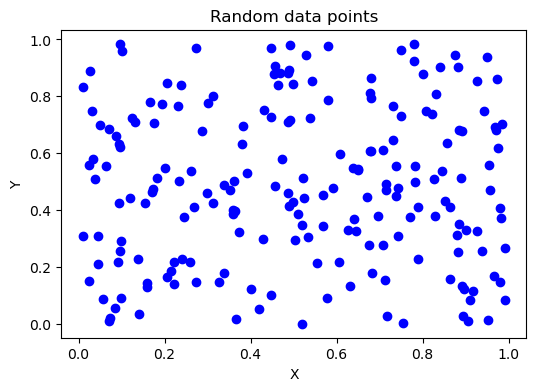 我们的任务是将上面的 200 个点划分为
我们的任务是将上面的 200 个点划分为 $k$ 类。K-means 的算法步骤为下:
- 随机选取
$k$个点作为最初始的中心点 (centroid) - 对 200 个点中的每个点
$i$,计算该点与每个中心点 (centroid) 的距离。如果距离第一个中心点最近,那$i$归为第一类,以此类推。 - 对每一个类中的所有点,取平均值,得到新的
$k$个中心点。 - 重复第二步与第三步,直到中心点无法继续更新(或者满足你自定义的条件,比如,新的中心点与之前的距离非常近)
写初步代码 #
下面,我们按照上面的步骤简单写一下 K-means。
# 数据维度,我们这里是二维的,也就是只有 x, y
n = 2
# 将数据分为多少个类
k = 2
# 最初的随机中心点
initial_centroids = np.random.rand(k, n)
# 初始化 clusters。clusters 为一个 list,该 list 包含 k 个子 list。每个子 list 是一个类
# 其里面的元素为划为该类的数据点
clusters = [[] for _ in range(k)]
# 对于每一个点
for d in data:
# 计算该点与每一个中心点的距离
distances = [np.linalg.norm(d - initial_centroids[c]) for c in range(k)]
# 看看距离哪一个中心点更近
min_distances_idx = np.argmin(distances)
# 将该点放进距离较近的中心点 (centroid) 所在的类别 (cluster)
clusters[min_distances_idx].append(d)
# 更新了 clusters 之后,我们继续更新 centroids。此时,两个 centroids 分别是各自所在 cluster 的中心,
# 也就是 mean
# axis = 0, by column
updated_centroids = np.array([np.mean(clusters[c], axis = 0) for c in range(k)])
好,我们已经更新了 clusters 和 centroids,让我们来看看现在的情况如何:
colors = ['b', 'orange', 'g', 'r', 'y', 'c', 'm']
plt.figure(figsize = (6, 4))
for i, cluster in enumerate(clusters):
cluster = np.array(cluster)
plt.scatter(cluster[:, 0], cluster[:, 1], c = colors[i], label=f"Cluster {i+1}")
plt.scatter(
initial_centroids[:, 0],
initial_centroids[:, 1],
c='k',
marker='x',
s = 100,
label="Initial Centroids"
)
plt.scatter(
updated_centroids[:, 0],
updated_centroids[:, 1],
c='purple',
marker='o',
s = 100,
label="Current Centroids"
)
plt.title("K-means Clustering (Iteration: 1)")
plt.xlabel("Feature 1")
plt.ylabel("Feature 2")
plt.legend()
plt.show()
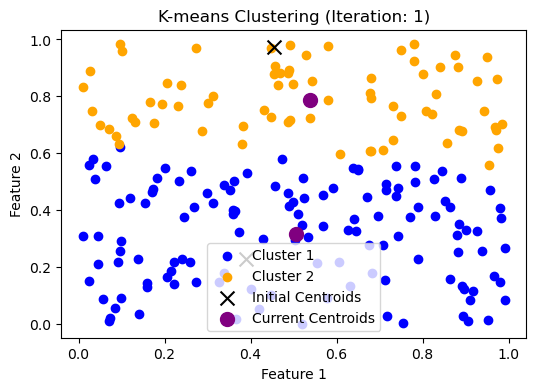 我们继续:
我们继续:
# 需要重新初始化 clusters
clusters = [[] for _ in range(k)]
# 对于每一个点
for d in data:
# 计算该点与每一个中心点的距离
distances = [np.linalg.norm(d - updated_centroids[c]) for c in range(k)]
# 看看距离哪一个中心点更近
min_distances_idx = np.argmin(distances)
# 将该点放进距离较近的中心点 (centroid) 所在的类别 (cluster)
clusters[min_distances_idx].append(d)
# 更新了 clusters 之后,我们继续更新 centroids。此时,两个 centroids 分别是各自所在 cluster 的中心,
# 也就是 mean
# axis = 0, by column
updated_centroids = np.array([np.mean(clusters[c], axis = 0) for c in range(k)])
colors = ['b', 'orange', 'g', 'r', 'y', 'c', 'm']
plt.figure(figsize = (6, 4))
for i, cluster in enumerate(clusters):
cluster = np.array(cluster)
plt.scatter(cluster[:, 0], cluster[:, 1], c = colors[i], label=f"Cluster {i+1}")
plt.scatter(
updated_centroids[:, 0],
updated_centroids[:, 1],
c='purple',
marker='o',
s = 100,
label="Current Centroids"
)
plt.title("K-means Clustering (Iteration: 2)")
plt.xlabel("Feature 1")
plt.ylabel("Feature 2")
plt.legend()
plt.show()
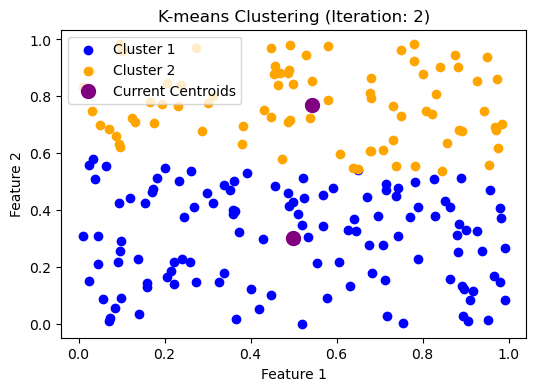 好,我们就不继续一步步做了。上面代码的问题是,每一步都需要重新写代码,这样不行。我们需要实现自动化。
好,我们就不继续一步步做了。上面代码的问题是,每一步都需要重新写代码,这样不行。我们需要实现自动化。
普适性代码 #
def kmeans_clustering(data, centroids):
"""
Inputs:
- data: data points to cluster
- centroids: previous centroids
Outputs:
- updated_centoids:
- clusters: a list.
Each list contains all arrays which are data points classified into this cluster
"""
# num of clusters
k = len(centroids)
# initialize empty clusters
clusters = [[] for _ in range(k)]
# for each data point
for d in data:
# calcuate distance from each centroid to this data point
distances = np.linalg.norm(d - centroids, axis = 1)
# the index of centroid that is the closest to this data point
min_distance_idx = np.argmin(distances)
# add this data point to the associated cluster
clusters[min_distance_idx].append(d)
# update centroids by calculating mean of each cluster
updated_centroids = np.array([np.mean(clusters[c], axis = 0) for c in range(k)])
return updated_centroids, clusters
def make_plot(clusters, centroids, iteration):
# Plotting the results
colors = ['b', 'g', 'r', 'y', 'c', 'm']
plt.figure(figsize=(6, 4))
for i, cluster in enumerate(clusters):
cluster = np.array(cluster)
if len(cluster) > 0:
plt.scatter(cluster[:, 0], cluster[:, 1],
c=colors[i], label=f'Cluster {i+1}')
# plt.scatter(initial_centroids[:, 0], initial_centroids[:, 1], c='k', marker='x', s=100, label='Initial Centroids')
plt.scatter(centroids[:, 0], centroids[:, 1], c='k',
marker='o', s=100, label='Centroids')
plt.title(f'K-means Clustering (Iteration: {iteration})')
plt.xlabel('Feature 1')
plt.ylabel('Feature 2')
plt.legend()
plt.show()
# num of dimensions
n = 2
# num of clusters
k = 2
# Convergence criteria
threshold = 1e-2
# generate random data
data = np.random.rand(200, n)
# random centroids as an initial stage; a k by n matrix
initial_centroids = np.random.rand(k, n)
# update centroids and clusters using our previous function
updated_centroids, clusters = kmeans_clustering(data, initial_centroids)
# num of iterations
iteration = 0
centroids = initial_centroids
# plot the initial state
make_plot([data], centroids, iteration)
# np.max(np.linalg.norm(updated_centroids - centroids, axis=1))
# this calculates the max shift among centroid shifts
while np.max(np.linalg.norm(updated_centroids - centroids, axis=1)) > threshold:
iteration += 1
make_plot(clusters, updated_centroids, iteration)
# updated centroids
centroids = updated_centroids
updated_centroids, clusters = kmeans_clustering(data, centroids)
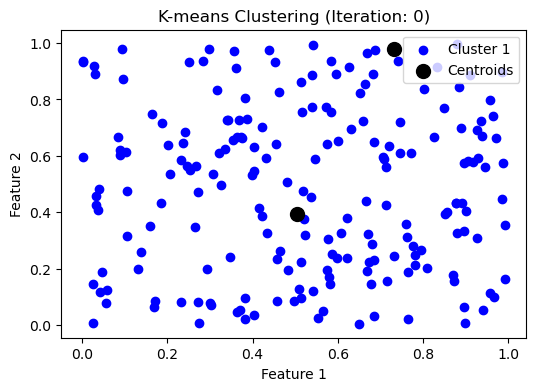
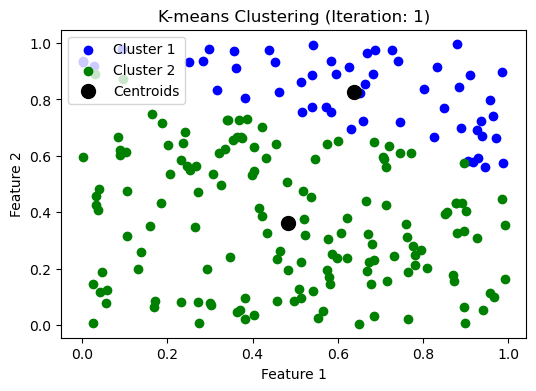
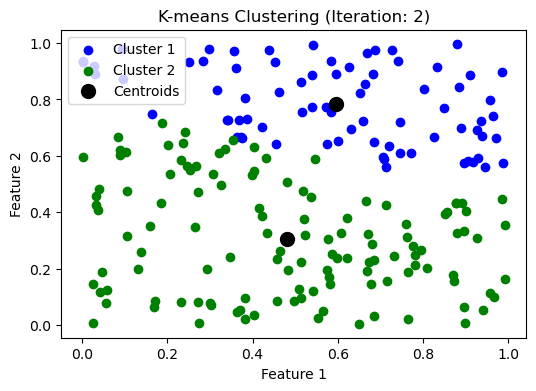

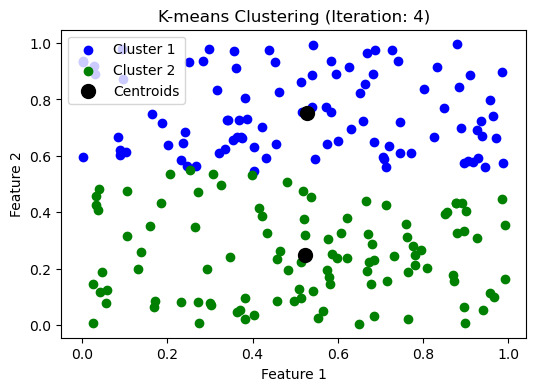
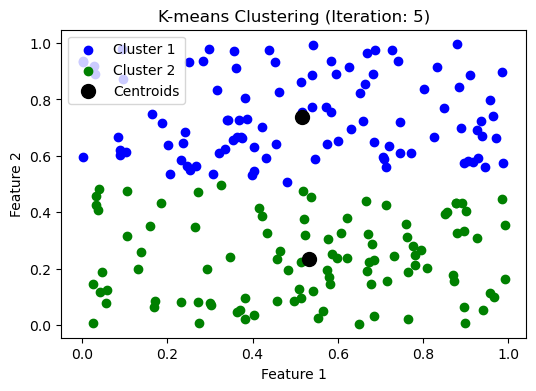
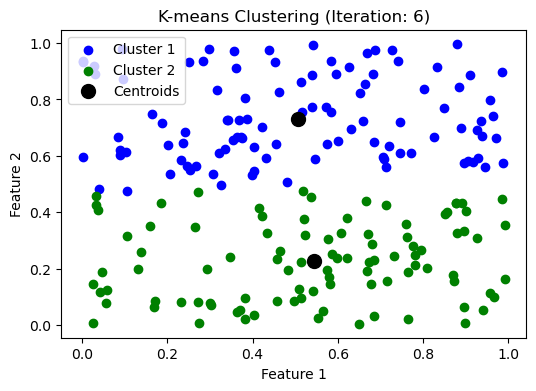
制作动画 #
上面的代码我们可以把每一步画出来,我们试试制作一个动画。
fig, ax = plt.subplots(figsize = (6, 4))
# Convergence criteria
threshold = 1e-3
# generate random data
data = np.random.rand(200, n)
# random centroids as an initial stage; a k by n matrix
initial_centroids = np.random.rand(k, n)
centroids = initial_centroids.copy()
def update(frame):
global centroids
ax.clear()
ax.set_title(f"K-means Clutering (Iteration: {frame})")
ax.set_xlabel("Feature 1")
ax.set_ylabel("Feature 2")
ax.set_xlim(0,1)
ax.set_ylim(0,1)
# plot nitial stage where there are two random centroids
if frame == 0:
ax.scatter(data[:, 0], data[:, 1], c="gray", label="Data Points")
ax.scatter(centroids[:, 0], centroids[:, 1],
c='k', marker='x', s=100, label='Initial Centroids'
)
ax.legend()
return
# update centroids and clusters using our previous function
updated_centroids, clusters = kmeans_clustering(data, centroids)
# make plot
colors = ['b', 'g', 'r', 'y', 'c', 'm']
for j, cluster in enumerate(clusters):
cluster = np.array(cluster)
if len(cluster) > 0:
ax.scatter(cluster[:, 0], cluster[:, 1], c=colors[j % len(colors)], label=f'Cluster {j+1}')
# plot centroids
ax.scatter(updated_centroids[:, 0], updated_centroids[:, 1], c='k',
marker='o', s=100, label='Centroids')
ax.legend()
# Check for convergence
max_centroid_change = np.max(np.linalg.norm(updated_centroids - centroids, axis=1))
if max_centroid_change < threshold:
anim.event_source.stop()
return
# Update centroids
centroids = updated_centroids
# Create the animation
anim = FuncAnimation(fig, update, frames=np.arange(20), interval=1000, repeat=False)
writer = FFMpegWriter(fps=1) # Adjust fps as needed
anim.save("img/kmeans_clustering.mp4", writer=writer)
# Show the animation
# plt.show()
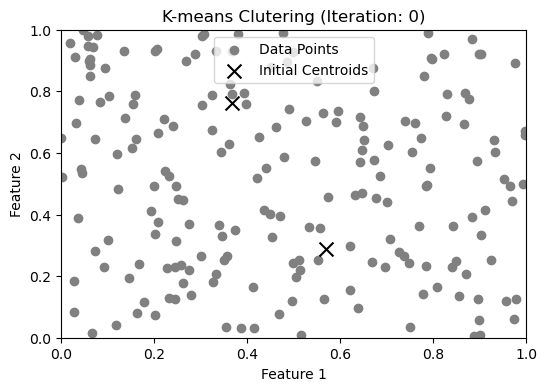 上面的动画视频在 这里
上面的动画视频在 这里
评估结果 #
我们现在重点不在可视化,我们主要看一下我们的代码是否正确。
def get_final_centroids_and_clusters(data, n_clusters, threshold, seed=None):
"""
Perform K-means clustering on the provided data.
Parameters:
data (numpy.ndarray): Data points to cluster.
n_clusters (int): Number of clusters.
threshold (float): Convergence threshold.
seed (int, optional): Random seed for reproducibility.
Returns:
updated_centroids (numpy.ndarray): Final centroids after clustering.
clusters (list): Data points classified into clusters.
"""
if seed is not None:
np.random.seed(seed)
data_size = data.shape[0]
# Initialize centroids by randomly sampling from the data
initial_centroids = data[np.random.choice(data_size, n_clusters, replace=False)]
updated_centroids, clusters = kmeans_clustering(data, initial_centroids)
centroids = initial_centroids
while np.max(np.linalg.norm(updated_centroids - centroids, axis=1)) > threshold:
centroids = updated_centroids
updated_centroids, clusters = kmeans_clustering(data, centroids)
return updated_centroids, clusters
def kmeans_clustering(data, centroids):
"""
Perform one iteration of K-means clustering.
Parameters:
data (numpy.ndarray): Data points to cluster.
centroids (numpy.ndarray): Current centroids.
Returns:
updated_centroids (numpy.ndarray): Updated centroids.
clusters (list): Data points classified into clusters.
"""
k = len(centroids)
clusters = [[] for _ in range(k)]
for d in data:
# Calculate distances from the data point to each centroid
distances = np.linalg.norm(d - centroids, axis=1)
# Find the index of the closest centroid
min_distance_idx = np.argmin(distances)
# Assign the data point to the closest centroid's cluster
clusters[min_distance_idx].append(d)
updated_centroids = []
for cluster in clusters:
if cluster:
updated_centroids.append(np.mean(cluster, axis=0))
else:
# Handle empty cluster by reinitializing the centroid randomly from the data
updated_centroids.append(data[np.random.choice(data.shape[0])])
return np.array(updated_centroids), clusters
height_weight_df = pd.read_csv("data/height_weight_data.csv")
height_weight_data = height_weight_df[['Height', 'Weight']].values
final_centroids, clusters = get_final_centroids_and_clusters(
height_weight_data, n_clusters=2, threshold=1e-3, seed = 0
)
final_centroids
array([[150.04743075, 59.32777344],
[171.59570541, 80.42337816]])
from sklearn.cluster import KMeans
kmeans = KMeans(n_clusters=2, random_state=0, n_init="auto").fit(height_weight_data)
kmeans.cluster_centers_
array([[150.04743075, 59.32777344],
[171.59570541, 80.42337816]])
我们看到我们的结果和 sklearn 的一致,那说明我们的没问题。但是缺少了一个功能:预测。比如,我随便给你一个数据点,[130, 66],它属于 cluster1 还是 cluster2?
我们接下来实现这个功能。
def predict(data, final_centroids):
"""
Predict the closest cluster each data point in the data belongs to.
Parameters:
data (numpy.ndarray): Data points to predict.
Returns:
labels (numpy.ndarray): Cluster labels for each data point.
"""
k = len(data)
labels = []
for d in data:
# Calculate distances from the data point to each centroid
distances = np.linalg.norm(d - final_centroids, axis=1)
# Find the index of the closest centroid
min_distance_idx = np.argmin(distances)
# That index is the label
labels.append(min_distance_idx)
return np.array(labels)
predict([[130, 66], [144, 55]], final_centroids), kmeans.predict([[130, 66], [144, 55]])
(array([0, 0]), array([0, 0], dtype=int32))
我们可以看到,我们写的这个函数,其结果和 sklearn 的结果一致。
进一步深化 #
接下来,我们要写一个 Python Class,而不是用三个独立的 def。
class KMeans:
def __init__(self, n_clusters, threshold, seed=None):
"""
Initialize the KMeans class with the number of clusters, convergence threshold, and optional random seed.
Parameters:
n_clusters (int): Number of clusters.
threshold (float): Convergence threshold.
seed (int, optional): Random seed for reproducibility.
"""
self.n_clusters = n_clusters
self.threshold = threshold
self.seed = seed
self.centroids = None
def fit(self, data):
"""
Fit the K-means algorithm to the data.
Parameters:
data (numpy.ndarray): Data points to cluster.
Returns:
self (KMeans): Fitted KMeans instance.
"""
if self.seed is not None:
np.random.seed(self.seed)
data_size = data.shape[0]
# Initialize centroids by randomly sampling from the data
initial_centroids = data[np.random.choice(data_size, self.n_clusters, replace=False)]
updated_centroids, clusters = kmeans_clustering(data, initial_centroids)
centroids = initial_centroids
while np.max(np.linalg.norm(updated_centroids - centroids, axis=1)) > self.threshold:
centroids = updated_centroids
updated_centroids, clusters = self._kmeans_clustering(data, centroids)
self.centroids = updated_centroids
self.clusters = clusters
return self
def _kmeans_clustering(self, data, centroids):
"""
Perform one iteration of K-means clustering.
Parameters:
data (numpy.ndarray): Data points to cluster.
centroids (numpy.ndarray): Current centroids.
Returns:
updated_centroids (numpy.ndarray): Updated centroids.
clusters (list): Data points classified into clusters.
"""
k = len(centroids)
clusters = [[] for _ in range(k)]
for d in data:
# Calculate distances from the data point to each centroid
distances = np.linalg.norm(d - centroids, axis=1)
# Find the index of the closest centroid
min_distance_idx = np.argmin(distances)
# Assign the data point to the closest centroid's cluster
clusters[min_distance_idx].append(d)
updated_centroids = []
for cluster in clusters:
if cluster:
updated_centroids.append(np.mean(cluster, axis=0))
else:
# Handle empty cluster by reinitializing the centroid randomly from the data
updated_centroids.append(data[np.random.choice(data.shape[0])])
return np.array(updated_centroids), clusters
def predict(self, data):
"""
Predict the closest cluster each data point in the data belongs to.
Parameters:
data (numpy.ndarray): Data points to predict.
Returns:
labels (numpy.ndarray): Cluster labels for each data point.
"""
labels = []
for d in data:
# Calculate distances from the data point to each centroid
distances = np.linalg.norm(d - self.centroids, axis=1)
# Find the index of the closest centroid
min_distance_idx = np.argmin(distances)
# That index is the label
labels.append(min_distance_idx)
return np.array(labels)
# Example usage:
# kmeans = KMeans(n_clusters=3, threshold=0.001, seed=42)
# kmeans.fit(data)
# labels = kmeans.predict(data)
kmeans = KMeans(n_clusters=2, threshold=0.001, seed = 0)
kmeans_result = kmeans.fit(height_weight_data)
kmeans_result.centroids
array([[150.04743075, 59.32777344],
[171.59570541, 80.42337816]])
kmeans.predict([[130, 66], [144, 55]])
array([0, 0])
#ML
最后一次修改于 2025-06-03 • 编辑本页